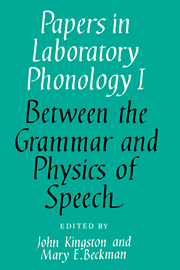Book contents
- Frontmatter
- Contents
- List of contributors
- Acknowledgements
- 1 Introduction
- 2 Where phonology and phonetics intersect: the case of Hausa intonation
- 3 Metrical representation of pitch register
- 4 The status of register in intonation theory: comments on the papers by Ladd and by Inkelas and Leben
- 5 The timing of prenuclear high accents in English
- 6 Alignment and composition of tonal accents: comments on Silverman and Pierrehumberf's paper
- 7 Macro and micro F0 in the synthesis of intonation
- 8 The separation of prosodies: comments on Kohler's paper
- 9 Lengthenings and shortenings and the nature of prosodic constituency
- 10 On the nature of prosodic constituency: comments on Beckman and Edwards's paper
- 11 Lengthenings and the nature of prosodic constituency: comments on Beckman and Edwards's paper
- 12 From performance to phonology: comments on Beckman and Edwards's paper
- 13 The Delta programming language: an integrated approach to nonlinear phonology, phonetics, and speech synthesis
- 14 The phonetics and phonology of aspects of assimilation
- 15 On the value of reductionism and formal explicitness in phonological models: comments on Ohala's paper
- 16 A response to Pierrehumbert's commentary
- 17 The role of the sonority cycle in core syllabification
- 18 Demisyllables as sets of features: comments on Clements's paper
- 19 Tiers in articulatory phonology, with some implications for casual speech
- 20 Toward a model of articulatory control: comments on Browman and Goldstein's paper
- 21 Gestures and autosegments: comments on Browman and Goldstein's paper
- 22 On dividing phonetics and phonology: comments on the papers by Clements and by Browman and Goldstein
- 23 Articulatory binding
- 24 The generality of articulatory binding: comments on Kingston's paper
- 25 On articulatory binding: comments on Kingston's paper
- 26 The window model of coarticulation: articulatory evidence
- 27 Some factors influencing the precision required for articulatory targets: comments on Keating's paper
- 28 Some regularities in speech are not consequences of formal rules: comments on Keating's paper
- Index of names
- Index of subjects
18 - Demisyllables as sets of features: comments on Clements's paper
Published online by Cambridge University Press: 08 February 2010
- Frontmatter
- Contents
- List of contributors
- Acknowledgements
- 1 Introduction
- 2 Where phonology and phonetics intersect: the case of Hausa intonation
- 3 Metrical representation of pitch register
- 4 The status of register in intonation theory: comments on the papers by Ladd and by Inkelas and Leben
- 5 The timing of prenuclear high accents in English
- 6 Alignment and composition of tonal accents: comments on Silverman and Pierrehumberf's paper
- 7 Macro and micro F0 in the synthesis of intonation
- 8 The separation of prosodies: comments on Kohler's paper
- 9 Lengthenings and shortenings and the nature of prosodic constituency
- 10 On the nature of prosodic constituency: comments on Beckman and Edwards's paper
- 11 Lengthenings and the nature of prosodic constituency: comments on Beckman and Edwards's paper
- 12 From performance to phonology: comments on Beckman and Edwards's paper
- 13 The Delta programming language: an integrated approach to nonlinear phonology, phonetics, and speech synthesis
- 14 The phonetics and phonology of aspects of assimilation
- 15 On the value of reductionism and formal explicitness in phonological models: comments on Ohala's paper
- 16 A response to Pierrehumbert's commentary
- 17 The role of the sonority cycle in core syllabification
- 18 Demisyllables as sets of features: comments on Clements's paper
- 19 Tiers in articulatory phonology, with some implications for casual speech
- 20 Toward a model of articulatory control: comments on Browman and Goldstein's paper
- 21 Gestures and autosegments: comments on Browman and Goldstein's paper
- 22 On dividing phonetics and phonology: comments on the papers by Clements and by Browman and Goldstein
- 23 Articulatory binding
- 24 The generality of articulatory binding: comments on Kingston's paper
- 25 On articulatory binding: comments on Kingston's paper
- 26 The window model of coarticulation: articulatory evidence
- 27 Some factors influencing the precision required for articulatory targets: comments on Keating's paper
- 28 Some regularities in speech are not consequences of formal rules: comments on Keating's paper
- Index of names
- Index of subjects
Summary
Clements addresses himself to one of the oldest issues in linguistics – namely, how syllables are formed out of constituent phonemic segments – and in doing so, makes a noteworthy step forward toward a rigorously formulated theory of sound patterns. What I can contribute to this endeavor, I hope, is a somewhat different perspective on the issue. My suggestions may be too radical to be immediately useful, but if they manage to direct phonologists' attention to some emerging findings in experimental phonetics, particularly articulatory studies, that are relevant to the very basis of nonlinear phonological theories like Clements's, and if we can thereby acquire a better understanding of the basic assumptions underlying the current theoretical development both in abstract and concrete representations, it will justify my participation in this forum of discussion.
It is crucial, from my point of view, to note that Clements's idea of a demisyllable's internal organization is different from the idea I have been developing over the years. For Clements, a well-formed string of (phonemic) segments constitutes a demisyllable; the demisyllable is the domain over which sonority constraints on segment organization work. My approach, in contrast, is to try to use demisyllables as minimal integral units in place of phonemes. From this point of view, I defined a demisyllable as a set of (unordered) feature specifications (Fujimura 1979: 474), even though originally my way of thinking was still more in terms of phonemic sequences.
- Type
- Chapter
- Information
- Papers in Laboratory Phonology , pp. 334 - 340Publisher: Cambridge University PressPrint publication year: 1990
- 2
- Cited by



